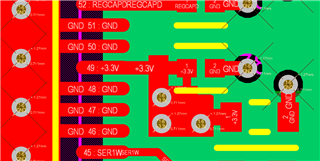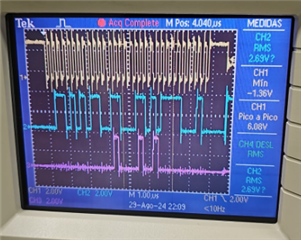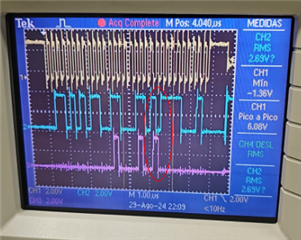Other Parts Discussed in Thread: ADS8681, DP83640
Tool/software:
I am using the ADS8686S in software serial mode with 1-wire data output, SDOA only.
I am interfacing with a STM32H723ZGT6 as Full-duplex master using these SPI settings:
hspi1.Instance = SPI1; hspi1.Init.Mode = SPI_MODE_MASTER; hspi1.Init.Direction = SPI_DIRECTION_2LINES; hspi1.Init.DataSize = SPI_DATASIZE_8BIT; hspi1.Init.CLKPolarity = SPI_POLARITY_HIGH; hspi1.Init.CLKPhase = SPI_PHASE_1EDGE; hspi1.Init.NSS = SPI_NSS_SOFT; hspi1.Init.BaudRatePrescaler = SPI_BAUDRATEPRESCALER_2; hspi1.Init.FirstBit = SPI_FIRSTBIT_MSB; hspi1.Init.TIMode = SPI_TIMODE_DISABLE; hspi1.Init.CRCCalculation = SPI_CRCCALCULATION_DISABLE; hspi1.Init.CRCPolynomial = 0x0; hspi1.Init.NSSPMode = SPI_NSS_PULSE_ENABLE; hspi1.Init.NSSPolarity = SPI_NSS_POLARITY_LOW; hspi1.Init.FifoThreshold = SPI_FIFO_THRESHOLD_01DATA; hspi1.Init.TxCRCInitializationPattern = SPI_CRC_INITIALIZATION_ALL_ZERO_PATTERN; hspi1.Init.RxCRCInitializationPattern = SPI_CRC_INITIALIZATION_ALL_ZERO_PATTERN; hspi1.Init.MasterSSIdleness = SPI_MASTER_SS_IDLENESS_00CYCLE; hspi1.Init.MasterInterDataIdleness = SPI_MASTER_INTERDATA_IDLENESS_00CYCLE; hspi1.Init.MasterReceiverAutoSusp = SPI_MASTER_RX_AUTOSUSP_DISABLE; hspi1.Init.MasterKeepIOState = SPI_MASTER_KEEP_IO_STATE_DISABLE; hspi1.Init.IOSwap = SPI_IO_SWAP_DISABLE;
When trying to read a register using SPI, this is what i'm doing:
uint16_t rx = 0;
uint16_t tx = (0 << 15) | ((ADS_DEVICE_ID & 0x3F) << 9) | 0x0;
HAL_StatusTypeDef ret;
HAL_GPIO_WritePin(ADC_CONVST_GPIO_Port, ADC_CONVST_Pin, GPIO_PIN_SET);
while (HAL_GPIO_ReadPin(ADC_BUSY_GPIO_Port, ADC_BUSY_Pin) == GPIO_PIN_SET)
{
}
HAL_GPIO_WritePin(ADC_CONVST_GPIO_Port, ADC_CONVST_Pin, GPIO_PIN_RESET);
// Send read register command
HAL_GPIO_WritePin(ADC_CS_GPIO_Port, ADC_CS_Pin, GPIO_PIN_RESET);
ret = HAL_SPI_TransmitReceive(&hspi1, (uint8_t*)&tx, (uint8_t*)&rx, 2, 10000);
HAL_GPIO_WritePin(ADC_CS_GPIO_Port, ADC_CS_Pin, GPIO_PIN_SET);
// Don't care
ret = HAL_SPI_TransmitReceive(&hspi1, (uint8_t*)&tx, (uint8_t*)&rx, 2, 10000);
// Receive register result
HAL_GPIO_WritePin(ADC_CS_GPIO_Port, ADC_CS_Pin, GPIO_PIN_RESET);
ret = HAL_SPI_TransmitReceive(&hspi1, (uint8_t*)&tx, (uint8_t*)&rx, 2, 10000);
HAL_GPIO_WritePin(ADC_CS_GPIO_Port, ADC_CS_Pin, GPIO_PIN_SET);
If I comment out the part where I start a conversion by setting CONVST high, the ADC doesn't return anything. Just returns 0x0, as you can see by the image:

At the final ReceiveTransmit command where i'm supposed to receive the register in it's default state (if I don't comment out the CONVST section), I get readings like this:

Or this:

If we take a look at the 8 least significant bits of the value in the rx buffer, I always see the value 0x35 (53 in decimal):

What am I doing wrong? Can someone point me in the right direction here, please? I'm thrilled to use this ADC in my power system protection relay...
Attached to this post is also the schematics for my design.






